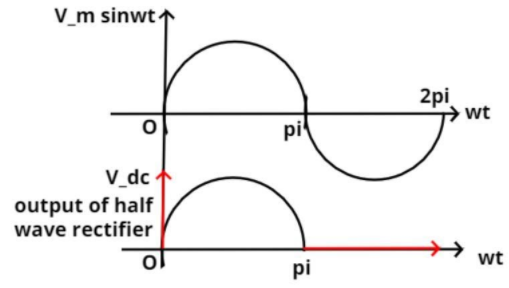
In a half-wave rectifier, the r.m.s value of the a.c component of the wave is
${\text{(a) equal to the dc value}} $
${\text{(b) more than the dc value}} $
${\text{(c) less than the dc value}} $
${\text{(d) zero}} $
Answer
587.4k+ views
Hint – In this question consider a sinusoidal equation of voltage that is $V = {V_m}\sin \omega t$, the dc voltage can be written as ${V_{D.C}} = \dfrac{{{V_m}}}{\pi }$ and the r.m.s value can be written as \[{V_{r.m.s}} = \sqrt {{{\left( {\dfrac{{{V_m}}}{{\sqrt 2 }}} \right)}^2}} \]. Use these to get the relation between the r.m.s value and the dc value.
Formula used: ${V_{D.C}} = \dfrac{{{V_m}}}{\pi }$, \[{V_{r.m.s}} = \sqrt {{{\left( {\dfrac{{{V_m}}}{{\sqrt 2 }}} \right)}^2}} \]
Complete step-by-step solution -

Let the sinusoidal voltage be
$V = {V_m}\sin \omega t$, where ${V_m}$ is maximum component of voltage and $\omega $ is the frequency.
Now as we know that the above signal is A.C single so the D.C component of this signal is zero.
But when we use half wave rectifier A.C signal is converted into D.C signal and the value of D.C voltage is
$ \Rightarrow {V_{D.C}} = \dfrac{{{V_m}}}{\pi }$volts.
And the r.m.s value of this A.C component is
\[ \Rightarrow {V_{r.m.s}} = \sqrt {{{\left( {\dfrac{{{V_m}}}{{\sqrt 2 }}} \right)}^2}} = \dfrac{{{V_m}}}{{\sqrt 2 }}\] volts.
So as we see that $\dfrac{{{V_m}}}{{\sqrt 2 }} > \dfrac{{{V_m}}}{\pi }$
Therefore, ${V_{r.m.s.}} > {V_{D.C}}$
So the r.m.s value of the A.C component of the wave is more than the D.C value.
So this is the required answer.
Hence option (B) is the required answer.
Note – A half wave rectifier is a rectifier that allows only one half cycle of an A.C voltage to pass through it, the diode present in the circuitry of half-wave rectifier is designed in such a way that it automatically gets reversed biased as soon as the negative half-cycle is passed through the input of the circuit.
Formula used: ${V_{D.C}} = \dfrac{{{V_m}}}{\pi }$, \[{V_{r.m.s}} = \sqrt {{{\left( {\dfrac{{{V_m}}}{{\sqrt 2 }}} \right)}^2}} \]
Complete step-by-step solution -

Let the sinusoidal voltage be
$V = {V_m}\sin \omega t$, where ${V_m}$ is maximum component of voltage and $\omega $ is the frequency.
Now as we know that the above signal is A.C single so the D.C component of this signal is zero.
But when we use half wave rectifier A.C signal is converted into D.C signal and the value of D.C voltage is
$ \Rightarrow {V_{D.C}} = \dfrac{{{V_m}}}{\pi }$volts.
And the r.m.s value of this A.C component is
\[ \Rightarrow {V_{r.m.s}} = \sqrt {{{\left( {\dfrac{{{V_m}}}{{\sqrt 2 }}} \right)}^2}} = \dfrac{{{V_m}}}{{\sqrt 2 }}\] volts.
So as we see that $\dfrac{{{V_m}}}{{\sqrt 2 }} > \dfrac{{{V_m}}}{\pi }$
Therefore, ${V_{r.m.s.}} > {V_{D.C}}$
So the r.m.s value of the A.C component of the wave is more than the D.C value.
So this is the required answer.
Hence option (B) is the required answer.
Note – A half wave rectifier is a rectifier that allows only one half cycle of an A.C voltage to pass through it, the diode present in the circuitry of half-wave rectifier is designed in such a way that it automatically gets reversed biased as soon as the negative half-cycle is passed through the input of the circuit.
Recently Updated Pages
Master Class 12 English: Engaging Questions & Answers for Success

Master Class 12 Business Studies: Engaging Questions & Answers for Success

Master Class 12 Economics: Engaging Questions & Answers for Success

Master Class 12 Social Science: Engaging Questions & Answers for Success

Master Class 12 Maths: Engaging Questions & Answers for Success

Master Class 12 Chemistry: Engaging Questions & Answers for Success

Trending doubts
What are the major means of transport Explain each class 12 social science CBSE

Which are the Top 10 Largest Countries of the World?

Draw a labelled sketch of the human eye class 12 physics CBSE

Explain sex determination in humans with line diag class 12 biology CBSE

Explain sex determination in humans with the help of class 12 biology CBSE

Differentiate between homogeneous and heterogeneous class 12 chemistry CBSE




